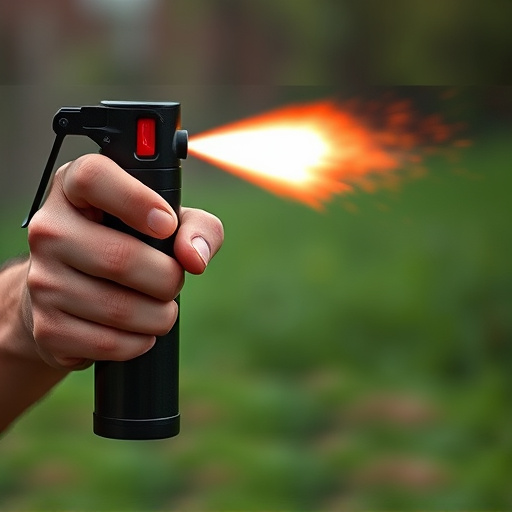OC (pepper) spray is a non-lethal self-defense tool that uses capsaicin, the active compound from chili peppers, to cause temporary blindness and breathing difficulties. Concentrations range from 1% to 5%, with tactical sprays typically around 1.5%-2.0% for balance between potency and control. Higher concentrations enhance knockdown but may cause collateral damage, while lower ones provide milder effects but less deterrence. Effective usage involves aiming at the face, practicing techniques like 'point and pull', and following safety guidelines including secure storage, understanding laws, regular inspection, and de-escalation training.
Tactical pepper spray is a powerful tool for personal safety, offering a non-lethal means of self-defense against potential threats. This comprehensive guide delves into the science behind OC spray and capsaicin, exploring their effectiveness and how concentration levels impact your protection. You’ll discover key factors to consider when choosing the right tactical spray, along with essential application techniques and safety measures to maximize its potency.
- Understanding OC Spray and Capsaicin: The Science Behind the Effectiveness
- Deciphering Concentration Levels: What Does it Mean for Self-Defense?
- Choosing the Right Tactical Pepper Spray: Factors to Consider
- Application Techniques and Safety Measures: Empowering Yourself with Knowledge
Understanding OC Spray and Capsaicin: The Science Behind the Effectiveness
OC spray, also known as pepper spray, is a non-lethal self-defense tool that uses capsaicin, the active ingredient found in chili peppers. The effectiveness of OC spray lies in its ability to cause temporary blindness, coughing, and difficulty breathing by irritating the eyes, nose, and respiratory system. Capsaicin concentration levels in these sprays vary, with higher concentrations offering more protection. Typically, they range from 1% to 2%, but specialized forms can reach up to 5%.
The science behind OC spray’s effectiveness is rooted in capsaicin’s chemical properties. When sprayed onto the skin or eyes, capsaicin binds to pain receptors, triggering a severe inflammatory response. This reaction leads to the symptoms associated with pepper spray exposure, providing users with crucial time to escape from potential threats. Understanding these factors is essential when choosing an OC spray for personal protection, as higher concentration levels generally translate to more potent and reliable performance in emergency situations.
Deciphering Concentration Levels: What Does it Mean for Self-Defense?
When considering tactical pepper spray for self-protection, understanding capsaicin concentration levels is crucial. These levels, measured in percent or milligrams per liter (mg/L), determine the potency and effectiveness of the spray. OC spray, a common term for oleoresin capsicum (OC) spray, typically ranges from 1.5% to 2.0% capsaicin. This concentration offers a powerful yet controlled dose, designed to temporarily disable an attacker without causing permanent harm.
The OC Spray Capsaicin Concentration Levels play a significant role in its self-defense applications. Higher concentrations can provide quicker knockdown and longer-lasting effects, but they may increase the risk of collateral damage or unintended exposure. Conversely, lower concentrations offer a milder sting, which could be beneficial in certain situations, but might not always deter an aggressor as effectively. Therefore, choosing the right concentration level depends on individual needs, threat assessment, and the desire for either swift immobilization or more gradual, controlled incapacitation.
Choosing the Right Tactical Pepper Spray: Factors to Consider
When selecting a tactical pepper spray for self-protection, understanding key factors is essential. One critical aspect is OC Spray Capsaicin Concentration Levels. These levels measure the potency of the spray and are typically expressed in percent capsaicin. Higher concentrations offer more effective immobilization but also increased risk and side effects. It’s important to balance personal safety needs with responsible usage.
Other factors to consider include spray range, duration of effect, weather conditions affecting visibility and effectiveness, and any specific requirements for legal carry or use. Additionally, training in proper application techniques is invaluable to ensure the spray works when needed and minimizes harm to yourself and others.
Application Techniques and Safety Measures: Empowering Yourself with Knowledge
Knowing how to apply tactical pepper spray effectively is crucial for self-defense. Start by understanding that OC (oleoresin capsicum) spray is designed to disrupt an attacker’s vision and breathing, providing you with a vital escape window. When using it, aim for the face—eyes, nose, and mouth—as these areas are most sensitive to capsaicin, the active ingredient in pepper spray. Practice different application techniques like the ‘point and pull’ method, where you point the nozzle towards your target’s face and quickly pull the trigger.
Safety measures are paramount when carrying and using tactical pepper spray. Always store it in a secure, accessible location, out of reach of children or unauthorized individuals. Be aware of local laws regarding its use and carry, as these vary significantly. Regularly inspect your spray for any signs of damage or wear, ensuring proper functionality. Moreover, educate yourself on de-escalation techniques to avoid unnecessary confrontations, as using pepper spray should always be a last resort.
When equipped with the right tactical pepper spray, understanding its active ingredient (OC Spray or Capsaicin), concentration levels, and proper application techniques, individuals can take control of their safety. By considering factors like spray range, weather conditions, and personal needs, one can make an informed decision to protect themselves effectively in potentially dangerous situations. Remember, knowledge is power, especially when it comes to self-defense tools like OC Spray.
